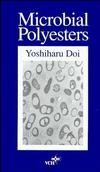Microbial PolyestersISBN: 978-0-471-18732-5
Hardcover
166 pages
December 1996
 This is a Print-on-Demand title. It will be printed specifically to fill your order. Please allow an additional 10-15 days delivery time. The book is not returnable.
|
||||||
Chapter 1 Introduction
1.1 Microbial Poly(3-hydroxybutyrate)
1.2 Microbial Poly(hydroxyalkanoates)
1.3 Environmentally Degradable Polyesters
References
Chapter 2 Fermentation and Analysis of Microbial Polyesters
2.1 Fermentation Production
2.1.1 Poly(3-hydroxybutyrate)
2.1.2 Poly(hydroxyalkanoates)
2.2 Polymer Isolation
2.2.1 Solvent Extraction
2.2.2 Alkaline Hypochlorite Treatment
2.2.3 Enzyme Treatment
2.3 Analysis
2.3.1 Polyester Content of Cells
2.3.2 Composition of Copolymers
2.3.3 Molecular Weight
References
Chapter 3 Microorganisms and Poly(3-hydroxyalkanoates)
3.1 Poly(3-hydroxybutyrate) in Microorganisms
3.1.1 Functions of Poly(3-hydroxybutyrate)
3.1.2 Structure of Native P(3HB) Granules
3.2 Biosynthesis of Poly(3-hydroxyalkanoates)
3.2.1 Alcaligenes eutrophus
3.2.2 Pseudomonas oleovorans
3.2.3 Other Bacterial Strains
3.3 Molecular Structures of Poly(3-hydroxyalkanoates)
3.3.1 Poly(3-hydroxybutyrate-co-3-hydroxyalerate)
3.3.2 Poly(3-hydroxyalkanoates-co-3-hydroxy--chloroalkanoates)
References
Chapter 4 Poly(3-hydroxyalkanoates) Metabolism
4.1 Pathways of Poly(3-hydroxybutyrate) Synthesis
4.2 Pathways of Poly(3-hydroxyalkanoates) Synthesis
4.3 Enzymology of Poly(3-hydroxyalkanoates) Synthesis
4.3.1 3-Ketothiolase
4.3.2 Acetoacetyl-CoA Reductase
4.3.3 P(3HB) Synthase
4.4 Pathways of P(3-hydroxybutyrate) Degradation
4.5 Cyclic Nature of Poly(3-hydroxyalkanoates) Metabolism
4.5.1 Replacement of P(3HB) by P(3HB-co-3HV)
4.5.2 Replacement of P(3HB-co-3HV) by P(3HB)
4.5.3 Application to PHA Fermentation
References
Chapter 5 Poly(3-hydroxybutyrate-co-4-hydroxybutyrate)
5.1 Alcaligenes eutrophus and Carbon Substrates
5.2 Molecular Structure
5.3 Biosynthetic Pathway
References
Chapter 6 Structure and Properties of Poly(3-hydroxybutyrate)
6.1 Crystal Structure and Properties
6.1.1 Crystal Structure
6.1.2 Solid-State Properties
6.2 Solution Properties
References
Chapter 7 Solid-State Properties of Copolyesters
7.1 Composition and Physical Properties
7.1.1 X-Ray Diffraction Analysis
7.1.2 Solid-State CP/MAS 13C-NMR Analysis
7.1.3 Mechanical Properties
7.2 Thermal Properties
7.2.1 Melting Temperatures
7.2.2 Glass-Transition Temperatures
7.2.3 Thermal Stability
7.3 Kinetics of Crystallization
References
Chapter 8 Biodegradation of Microbial Polyesters
8.1 Extracellular P(3HB) Depolymerase
8.1.1 Pseudomonas lemoignei
8.1.2 Alcaligenes faecalis
8.2 Enzymatic Hydrolysis of Copolyesters
8.3 Simple Hydrolysis of Polyesters
8.4 Applications and Prospects
8.4.1 Environmentally Degradable Plastics
8.4.2 Medical Applications
References
Index
1.1 Microbial Poly(3-hydroxybutyrate)
1.2 Microbial Poly(hydroxyalkanoates)
1.3 Environmentally Degradable Polyesters
References
Chapter 2 Fermentation and Analysis of Microbial Polyesters
2.1 Fermentation Production
2.1.1 Poly(3-hydroxybutyrate)
2.1.2 Poly(hydroxyalkanoates)
2.2 Polymer Isolation
2.2.1 Solvent Extraction
2.2.2 Alkaline Hypochlorite Treatment
2.2.3 Enzyme Treatment
2.3 Analysis
2.3.1 Polyester Content of Cells
2.3.2 Composition of Copolymers
2.3.3 Molecular Weight
References
Chapter 3 Microorganisms and Poly(3-hydroxyalkanoates)
3.1 Poly(3-hydroxybutyrate) in Microorganisms
3.1.1 Functions of Poly(3-hydroxybutyrate)
3.1.2 Structure of Native P(3HB) Granules
3.2 Biosynthesis of Poly(3-hydroxyalkanoates)
3.2.1 Alcaligenes eutrophus
3.2.2 Pseudomonas oleovorans
3.2.3 Other Bacterial Strains
3.3 Molecular Structures of Poly(3-hydroxyalkanoates)
3.3.1 Poly(3-hydroxybutyrate-co-3-hydroxyalerate)
3.3.2 Poly(3-hydroxyalkanoates-co-3-hydroxy--chloroalkanoates)
References
Chapter 4 Poly(3-hydroxyalkanoates) Metabolism
4.1 Pathways of Poly(3-hydroxybutyrate) Synthesis
4.2 Pathways of Poly(3-hydroxyalkanoates) Synthesis
4.3 Enzymology of Poly(3-hydroxyalkanoates) Synthesis
4.3.1 3-Ketothiolase
4.3.2 Acetoacetyl-CoA Reductase
4.3.3 P(3HB) Synthase
4.4 Pathways of P(3-hydroxybutyrate) Degradation
4.5 Cyclic Nature of Poly(3-hydroxyalkanoates) Metabolism
4.5.1 Replacement of P(3HB) by P(3HB-co-3HV)
4.5.2 Replacement of P(3HB-co-3HV) by P(3HB)
4.5.3 Application to PHA Fermentation
References
Chapter 5 Poly(3-hydroxybutyrate-co-4-hydroxybutyrate)
5.1 Alcaligenes eutrophus and Carbon Substrates
5.2 Molecular Structure
5.3 Biosynthetic Pathway
References
Chapter 6 Structure and Properties of Poly(3-hydroxybutyrate)
6.1 Crystal Structure and Properties
6.1.1 Crystal Structure
6.1.2 Solid-State Properties
6.2 Solution Properties
References
Chapter 7 Solid-State Properties of Copolyesters
7.1 Composition and Physical Properties
7.1.1 X-Ray Diffraction Analysis
7.1.2 Solid-State CP/MAS 13C-NMR Analysis
7.1.3 Mechanical Properties
7.2 Thermal Properties
7.2.1 Melting Temperatures
7.2.2 Glass-Transition Temperatures
7.2.3 Thermal Stability
7.3 Kinetics of Crystallization
References
Chapter 8 Biodegradation of Microbial Polyesters
8.1 Extracellular P(3HB) Depolymerase
8.1.1 Pseudomonas lemoignei
8.1.2 Alcaligenes faecalis
8.2 Enzymatic Hydrolysis of Copolyesters
8.3 Simple Hydrolysis of Polyesters
8.4 Applications and Prospects
8.4.1 Environmentally Degradable Plastics
8.4.2 Medical Applications
References
Index



